Wai-Fah Chen.The Civil Engineering Handbook
Подождите немного. Документ загружается.

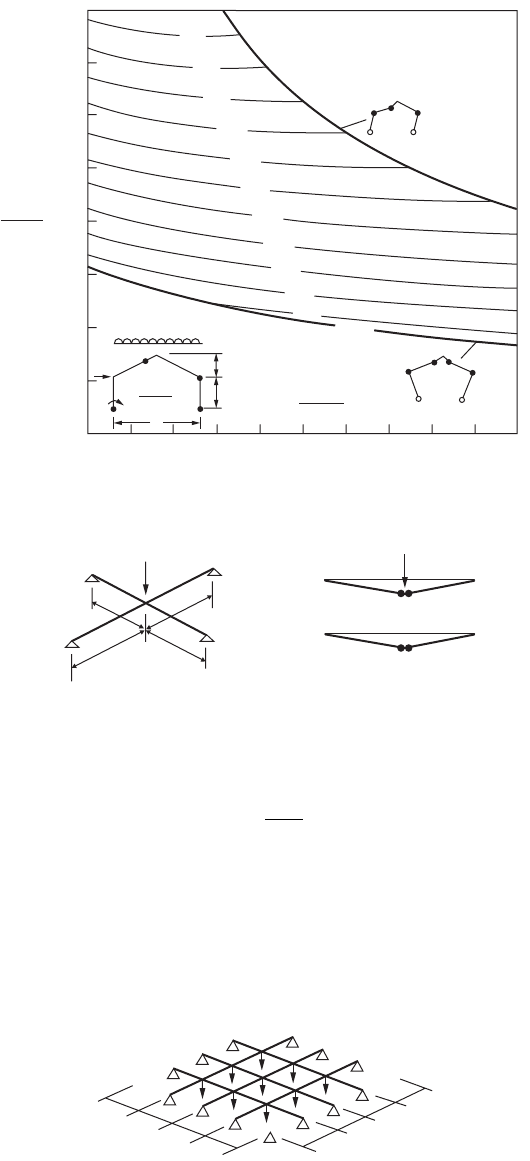
Theory and Analysis of Structures 47-131
of which the collapse load is
Six-Beam Grillage
A grillage consisting of six beams of span length 4L each and full plastic moment M
p
is shown in
Fig. 47.109. A total load of 9W acts on the grillage, splitting into concentrated loads W at the nine nodes.
Three collapse mechanisms are possible. Ignoring member twisting due to torsional forces, the work
equations associated with the three collapse mechanisms are computed as follows:
Mechanism 1 (Fig. 47.110a):
FIGURE 47.107 Analysis chart for fixed gable frame.
FIGURE 47.108 Two-beam grillage system.
FIGURE 47.109 Six-beam grillage system.
Sway mechanism
0.16
0.14
0.12
0.10
0.08
0.06
0.04
0.02
0
U
.
2
λωL
2
M
p
λωL
2
U =
2λ
1
Hh
1
λωL
2
λωL
L
λ
1
H
h
1
kh
1
k = 0.1 0.2 0.3 0.4 0.5 0.6 0.7 0.8 0.9 1.0
Gable mechanism
0.7
0.8
0.9
1.0
1.1
1.2
0.6
0.3
0.4
0.5
0.2
U=0
A
D
L
L
L
L
W
B
C
A
DB
C
W
W
M
L
p
=
4
L
L
L
L
L
L
L
L
w
w
w
w
w
w
w
w
w
© 2003 by CRC Press LLC

47-132 The Civil Engineering Handbook, Second Edition
Work equation:
of which
Mechanism 2 (Fig. 47.110b):
FIGURE 47.110 Six-beam grillage system: (a) mechanism 1, (b) mechanism 2, (c) mechanism 3.
ABC
1
2
3
Grid line A, B and C
Grid line B
Grid line BGrid line A and C
Grid line 1 and 3
Grid line 2
Grid line 1, 2 and 3
Grid line 2
B
(a)
(b)
θθ
θ
θ
θ
θθ
θθ
θ
θθ
2θ 2θ
θ
2θ
2θ
θ
θθ
2
ABC
1
2
3
(c)
912wL M
p
qq=
w
M
L
M
L
pp
==
12
9
4
3
© 2003 by CRC Press LLC

Theory and Analysis of Structures 47-133
Work equation:
of which
Mechanism 3 (Fig. 47.110c):
Work equation:
of which
The lowest upper bound load corresponds to mechanism 3. This can be confirmed by conducting a
moment check to ensure that bending moments anywhere are not violating the plastic moment condition.
Additional discussion of plastic analysis of grillages can be found in Baker and Heyman (1969) and
Heyman (1971).
Vierendeel Girders
Figure 47.111 shows a simply supported girder in which all members are rigidly joined and have the
same plastic moment M
p
. It is assumed that axial loads in the members do not cause member instability.
Two possible collapse mechanisms are considered, as shown in Fig. 47.111b to c.
The work equation for mechanism 1 is
so that
The work equation for mechanism 2 is
or
It can be easily proved that the collapse load associated with mechanism 2 is the correct limit load. This
is done by constructing an equilibrium set of bending moments and checking that they are not violating
the plastic moment condition.
wL M
p
qq= 8
w
M
L
p
=
8
wL wL M
p
22 4 2 4 8qqqq+¥ = +
()
w
M
L
p
=
WL M
p
320qq=
W
M
L
p
=
20
3
WL M
p
316qq=
W
M
L
p
=
16
3
© 2003 by CRC Press LLC

47-134 The Civil Engineering Handbook, Second Edition
Hinge-by-Hinge Analysis
Instead of finding the collapse load of the frame, it may be useful to obtain information about the
distribution and redistribution of forces prior to reaching the collapse load. Elastic-plastic hinge analysis
(also known as hinge-by-hinge analysis) determines the order of plastic hinge formation, the load factor
associated with each plastic hinge formation, and member forces in the frame between each hinge
formation. Thus the state of the frame can be defined at any load factor rather than only at the state of
collapse. This allows a more accurate determination of member forces at the design load level.
Educational and commercial software are now available for elastic-plastic hinge analysis (Chen and
Sohal, 1995). The computations of deflections for simple beams and multistory frames can be done using
the virtual work method (Chen and Sohal, 1995; ASCE, 1971; Beedle, 1958; Knudsen et al., 1953). The
basic assumption of first-order elastic-plastic hinge analysis is that the deformations of the structure are
insufficient to alter radically the equilibrium equations. This assumption ceases to be true for slender
members and structures, and the method gives unsafe predictions of limit loads.
47.12 Stability of Structures
Stability Analysis Methods
Several stability analysis methods have been utilized in research and practice. Figure 47.112 shows sche-
matic representations of the load-displacement results of a sway frame obtained from each type of analysis
to be considered.
Elastic Buckling Analysis
The elastic buckling load is calculated by linear buckling or bifurcation (or eigenvalue) analysis. The
buckling loads are obtained from the solutions of idealized elastic frames subjected to loads that do not
FIGURE 47.111 Collapse mechanism of a Vierendeel girder.
L
W
LLLL
(a)
(b)
W
(c)
W
4θ
4θL
3θL
3θ
3θ
3θ
3θ
4θ
4θ
4θ
θ
θθ
θ
θ
θ
θ
θ
θ
© 2003 by CRC Press LLC
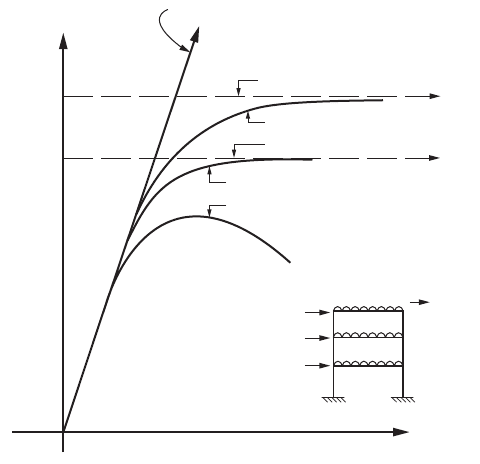
Theory and Analysis of Structures 47-135
produce direct bending in the structure. The only displacements that occur before buckling occurs are
those in the directions of the applied loads. When buckling (bifurcation) occurs, the displacements
increase without bound, assuming linearized theory of elasticity and small displacement, as shown by
the horizontal straight line in Fig. 47.112. The load at which these displacements occur is known as the
buckling load, commonly referred to as the bifurcation load. For structural models that actually exhibit
a bifurcation from the primary load path, the elastic buckling load is the largest load that the model can
sustain, at least within the vicinity of the bifurcation point, provided that the postbuckling path is in
unstable equilibrium. If the secondary path is in stable equilibrium, the load can still increase beyond
the critical load value.
Buckling analysis is a common tool for calculations of column effective lengths. The effective length
factor of a column member can be calculated using the procedure described later. The buckling analysis
provides useful indices of the stability behavior of structures; however, it does not predict actual behavior
of all structures, but of idealized structures with gravity loads applied only at the joints.
Second-Order Elastic Analysis
The analysis is formulated based on the deformed configuration of the structure. When derived rigorously,
a second-order analysis can include both the member curvature (P-d) and the side sway (P-D) stability
effects. The P-d effect is associated with the influence of the axial force acting through the member
displacement with respect to the rotated chord, whereas the P-D effect is the influence of the axial force
acting through the relative side sway displacements of the member ends. A structural system will become
stiffer when its members are subjected to tension. Conversely, the structure will become softer when its
members are in compression. Such behavior can be illustrated by a simple model shown in Fig. 47.113.
There is a clear advantage for a designer to take advantage of the stiffer behavior of tension structures.
However, the detrimental effects associated with second-order deformations due to compression forces
must be considered in designing structures subjected to predominant gravity loads.
Unlike the first-order analysis, in which solutions can be obtained in a rather simple and direct manner,
the second-order analysis often requires an iterative procedure to obtain solutions. The load-displacement
curve generated from a second-order elastic analysis will gradually approach the horizontal straight line,
which represents the buckling load obtained from the elastic buckling analysis, as shown in Fig. 47.112.
FIGURE 47.112 Catagorization of stability analysis methods.
Deflection, ∆
Second order inelastic analysis
First order elastic – plastic analysis
Rigid plastic load
Second order elastic analysis
Elastic buckling load
Linear elastic analysis
Load
factor
1
ω
1
ω
2
ω
3
H
1
H
2
H
3
∆
© 2003 by CRC Press LLC
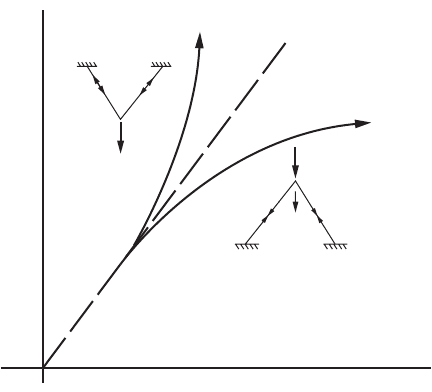
47-136 The Civil Engineering Handbook, Second Edition
Differences in the two limit loads may arise from the fact that the elastic stability limit is calculated for
equilibrium based on the deformed configuration, whereas the elastic critical load is calculated as a
bifurcation from equilibrium on the undeformed geometry of the frame.
The load-displacement response of many practical structures usually does not involve any bifurcation
of the equilibrium path. In some cases, the second-order elastic incremental response may not have
yielded any limit. See Chen and Lui (1987) for a basic discussion of these behavioral issues.
Recent works on second-order elastic analysis have been reported in Liew et al. (1991), White and
Hajjar (1991), Chen and Lui (1991), and Chen and Toma (1994), among others. Second-order analysis
programs that can take into consideration connection flexibility are also available (Chen et al., 1996;
Chen and Kim, 1997; Faella et al., 2000).
Second-Order Inelastic Analysis
Second-order inelastic analysis refers to methods of analysis that can capture geometrical and material
nonlinearities of the structures. The most rigorous inelastic analysis method is called spread-of-plasticity
analysis. It involves discretization of a member into many line segments and the cross-section of each
segment into a number of finite elements. Inelasticity is captured within the cross-sections and along
the member length. The calculation of forces and deformations in the structure after yielding requires
iterative trial-and-error processes because of the nonlinearity of the load–deformation response and the
change in the cross section effective stiffness at inelastic regions associated with the increase in the applied
loads and the change in structural geometry. Although most spread-of-plasticity analysis methods have
been developed for planar analysis (White, 1985; Vogel, 1985), three-dimensional spread-of-plasticity
techniques are also available involving various degrees of refinements (Clark, 1994; White, 1988; Wang,
1988; Chen and Atsuta, 1977; Jiang et al, 2002).
The simplest second-order inelastic analysis is the elastic-plastic hinge approach. The analysis assumes
that the element remains elastic except at its ends, where zero-length plastic hinges are allowed to form.
Plastic hinge analysis of planar frames can be found in Orbison (1982), Ziemian et al. (1992a, 1992b),
White et al. (1993), Liew et al. (1993), Chen and Toma (1994), Chen and Sohal (1995), and Chen et al.
(1996). Advanced analyses of three-dimensional frames are reported in Chen et al. (2000) and Liew et al.
(2000). Second-order plastic hinge analysis allows efficient analysis of large-scale building frames. This
is particularly true for structures in which the axial forces in the component members are small and the
behavior is predominated by bending actions. Although elastic-plastic hinge approaches can provide
essentially the same load-displacement predictions as second-order plastic-zone methods for many frame
FIGURE 47.113 Behavior of frame in compression and tension.
P,∆
P
Tension
Compression
P
∆
∆
© 2003 by CRC Press LLC
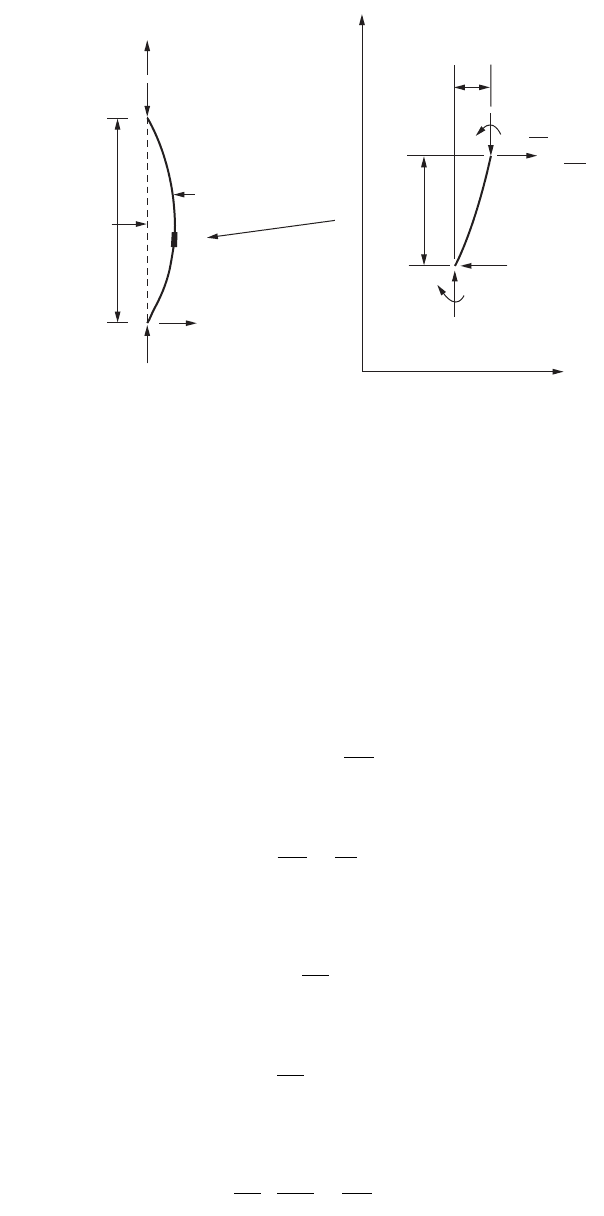
Theory and Analysis of Structures 47-137
problems, they cannot be classified as advanced analysis for use in frame design. Some modifications to
the elastic-plastic hinge are required to qualify the methods as advanced analysis; they are discussed later.
Figure 47.112 shows the load-displacement curve (a smooth curve with a descending branch) obtained
from the second-order inelastic analysis. The computed limit load should be close to that obtained from
the plastic-zone analysis.
Column Stability
Stability Equations
The stability equation of a column can be obtained by considering an infinitesimal deformed segment
of the column, as shown in Fig. 47.114. Considering the moment equilibrium about point b, we obtain
or, upon simplification,
(47.239)
Summing the force horizontally, we can write
or, upon simplification,
(47.240)
Differentiating Eq. (47.239) with respect to x, we obtain
(47.241)
FIGURE 47.114 Stability equations of a column segment.
x
DEFLECTED SHAPE
b
a
L
ORIGINAL SHAPE
y
P
y
P
M
Q
a
dx
b
P
dy
M +
dx
Q +
dx
dM
dx
dQ
dx
x
P
Qdx Pdy M M
dM
dx
dx++-+
Ê
Ë
Á
ˆ
¯
˜
=0
Q
dM
dx
P
dy
dx
=-
-+ +
Ê
Ë
Á
ˆ
¯
˜
=QQ
dQ
dx
dx 0
dQ
dx
=0
dQ
dx
dM
dx
P
dy
dx
=-
2
2
2
2
© 2003 by CRC Press LLC
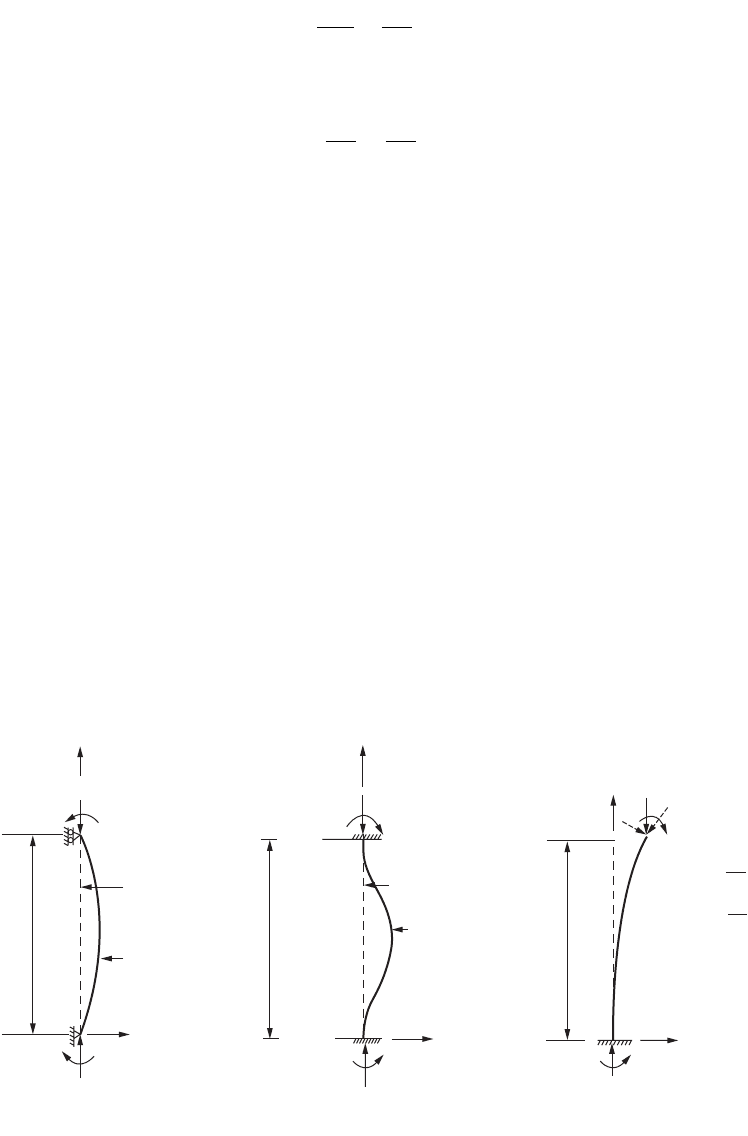
47-138 The Civil Engineering Handbook, Second Edition
which, when compared with Eq. (47.240), gives
(47.242)
Since moment M = –EI(d
2
y/dx
4
), Eq. (47.242) can be written as
(47.243)
or
(47.244)
Equation (47.244) is the general fourth-order differential equation that is valid for all support condi-
tions. The general solution to this equation is
(47.245)
To determine the critical load, it is necessary to have four boundary conditions: two at each end of
the column. In some cases, both geometric and force boundary conditions are required to eliminate the
unknown coefficients (A, B, C, and D) in Eq. (47.245).
Column with Pinned Ends
For a column pinned at both ends, as shown in Fig. 47.115a, the four boundary conditions are:
(47.246)
(47.247)
Since M = –EIy≤, the moment conditions can be written as
(47.248)
FIGURE 47.115 Column with: (a) pinned ends, (b) fixed ends, (c) fixed–free ends.
dM
dx
P
dy
dx
2
2
2
2
0-=
EI
dy
dx
P
dy
dx
4
4
2
2
0+=
yky
IV
+
¢¢
=
2
0
yA kxB kxCxD=+++sin cos
yx Mx=
()
==
()
=00 00,
yx L Mx L=
()
==
()
=00,
¢¢
()
=
¢¢
=
()
=yyxL00 0 and
x
M = 0
P
ORIGINAL
SHAPE
DEFLECTED
SHAPE
L
L
y
M = 0
P
(a) (b) (c)
P
P
y
y
V = 0
M ≠ 0
M ≠ 0
P∆
V = 0
x
P
x
P
M = 0
L
ORIGINAL SHAPE
DEFLECTED
SHAPE
dy
dx
V
ext
= P
V
Int
= −EI
d
3
y
dx
3
© 2003 by CRC Press LLC

Theory and Analysis of Structures 47-139
Using these conditions, we have
(47.249)
The deflection function (Eq. 47.245) reduces to
(47.250)
Using the conditions y(L) = y≤(L) = 0, Eq. (47.250) gives
(47.251)
and
(47.252)
(47.253)
If A = C = 0, the solution is trivial. Therefore, to obtain a nontrivial solution, the determinant of the
coefficient matrix of Eq. (47.253) must be zero, i.e.,
(47.254)
or
(47.255)
Since k
2
L cannot be zero, we must have
(47.256)
or
(47.257)
The lowest buckling load corresponds to the first mode obtained by setting n = 1:
(47.258)
Column with Fixed Ends
The four boundary conditions for a fixed-end column are (Fig. 47.115b):
(47.259)
(47.260)
Using the first two boundary conditions, we obtain
(47.261)
The deflection function (Eq. 47.245) becomes
(47.262)
BD==0
yA kxCx=+sin
AkLCLsin +=0
-=Ak kL
2
0sin
sin
sin
kL L
kkL
A
C-
È
Î
Í
˘
˚
˙
È
Î
Í
˘
˚
˙
=
È
Î
Í
˘
˚
˙
2
0
0
0
det
sin
sin
kL L
kkL-
=
2
0
0
kL kL
2
0sin =
sin kL = 0
kL n== ºp, n 1, 2, 3,
P
EI
L
cr
=
p
2
2
yx y x=
()
=
¢
=
()
=000
yx L y x L=
()
=
¢¢¢
=
()
= 0
DBCAk=- =-,
yA kxkx B kx=-
()
+-
()
sin cos 1
© 2003 by CRC Press LLC

47-140 The Civil Engineering Handbook, Second Edition
Using the last two boundary conditions, we have
(47.263)
For a nontrivial solution, we must have
(47.264)
or, after expanding,
(47.265)
Using trigonometric identities sin kL = 2 sin (kL/2) cos (kL/2) and cos kL = 1 – 2 sin
2
(kL/2), Eq. (47.265)
can be written as
(47.266)
The critical load for the symmetric buckling mode is P
cr
= 4p
2
EI/L
2
by letting sin (kL/2) = 0. The
buckling load for the antisymmetric buckling mode is P
cr
= 80.8EI/L
2
by letting the bracket term in
Eq. (47.266) equal zero.
Column with One End Fixed and One End Free
The boundary conditions for a fixed–free column are (Fig. 47.115c):
(47.267)
at the fixed end and
(47.268)
and at the free end. The moment M = EIy is equal to zero, and the shear force V = –dM/dx = –EI is
equal to Py¢, which is the transverse component of P acting at the free end of the column:
(47.269)
It follows that the shear force condition at the free end has the form
(47.270)
Using the boundary conditions at the fixed end, we have
(47.271)
The boundary conditions at the free end give
(47.272)
In matrix form, Eqs. (47.271) and (47.272) can be written as
(47.273)
sin cos
cos sin
kL kL kL
kL kL
A
B
--
--
È
Î
Í
˘
˚
˙
È
Î
Í
˘
˚
˙
=
È
Î
Í
˘
˚
˙
1
1
0
0
det
sin cos
cos sin
kL kL kL
kL kL
--
--
È
Î
Í
˘
˚
˙
=
1
1
0
kL kL kLsin cos+-=220
sin cos sin
kL kL kL kL
22 2 2
0-
Ê
Ë
Á
ˆ
¯
˜
=
yx y x=
()
=
¢
=
()
=000
¢¢
=
()
=yx L 0
VEIyPy=-
¢¢¢
=
¢
¢¢¢
+
¢
=yky
2
0
BD AkC+= +=00, and
AkLBkL Csin cos ,+= =00 and
011
00
0
0
0
0
k
kL kL
A
B
Csin cos
È
Î
Í
Í
Í
˘
˚
˙
˙
˙
È
Î
Í
Í
Í
˘
˚
˙
˙
˙
=
È
Î
Í
Í
Í
˘
˚
˙
˙
˙
© 2003 by CRC Press LLC
